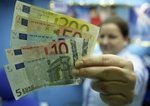By Mohamed A. El-Erian
The opinions expressed are his own.
With its high unemployment and stretched balance sheets, today’s US economy can ill-afford a negative shock from abroad. Yet, this is what it is experiencing. And it explains why markets go through bouts of nervousness about the debt crisis in Europe, and why American policymakers are worried about a foreign financial situation that is getting worse by the day.
Europe’s debt problem is indeed a headwind for what remains a disappointing US economic recovery. It dampens America’s export prospects, can raise the cost of borrowing for some American companies and diminishes an already low enthusiasm among banks to lend to households and small companies.
Having said that, it is unlikely, though not inconceivable, that Europe’s debt crisis would constitute a “Lehman Moment” — a situation that totally paralyzes American economic activity, puts the country on the verge of a depression and triggers yet another round of extreme crisis management measures.
There is now broad-based recognition of America’s persistent economic weakness. Most recently, the Federal Reserve has been forced again to revise downwards its growth projections for both 2011 and 2012. Moreover, with refreshing candor that speaks well to the uncertainties felt by the average American, Fed Chairman Ben Bernanke acknowledged in his second ever press conference on June 22 that only part of the economic weakness is due to transitory factors such as higher oil prices and supply disruptions associated with the Japanese tragedies.
As Bernanke hinted, and as PIMCO’s analyses have demonstrated for a while, the US unfortunately faces four structural headwinds that are yet to be addressed properly by policymakers.
First, and nearly three years after the global financial crisis, the US housing market is still unable to find a firm enough footing. This undermines confidence and limits labor mobility.
Second, joblessness remains worrisomely high, and to make things even worse, is increasingly structural in nature. Witness the 9% unemployment rate, declining labor participation and an alarming 24% unemployment rate among 16-19 year-olds and a 40% rate for African-Americans.
Third, credit is yet to flow properly in the economy. With bank lending still hampered, it is small companies and poorer households that suffer the most.
Fourth, there is a problem of debt and leverage. Coming off a “great age” of debt and credit-entitlement that went way too far, balance sheet rehabilitation has been uneven and generally insufficient. Yes, some sectors, led by multinational companies, have recovered strongly. But far too many in the private sector are still over-indebted. Meanwhile, public balance sheets, be they of the Federal Reserve or the fiscal agencies, are contaminated to such an extent that they now constitute a source of medium-term uncertainty.
Policy responses have been too timid in the face of the economic challenges, and for too long, lacking a central vision. Instead, they have been ad hoc, too reactive and lacking sufficient structural underpinnings.
In the absence of a credible alternative, the role of the country’s main economic spokesperson has fallen to President Obama who, understandably and correctly, is extremely busy with many other national and international priorities. Meanwhile, the other arms of government — Congress in particular — are hostage to extreme political polarization, posturing and bickering. And the recurrent drama associated with budgetary legislation discussions — including the continuing budgetary resolution of a few months ago or today’s debt ceiling debate — adds to the uncertainties facing the nation.
In sum, this is not an economy that is well positioned to deal with a shock from abroad, let alone a major one. Its ability to absorb a systemic shock has been worn down by persistent internal economic weaknesses and the agility needed to sidestep, or at least minimize the impact of the shock, has been eroded by slow economic policy responses and stretched balance sheets.
All this helps to explain America’s concern about Europe’s debt crisis, which has led to periodic selloffs in capital markets and warnings from policymakers. It also speaks to why some commentators have gone as far to suggest that the country faces another “Lehman Moment” — a devastating shock that totally paralyzes the economy, disrupts the functioning of the financial system and pushes the country to the verge of a great depression.
This situation was last faced in the fourth quarter of 2008 following the disorderly collapse of Lehman Brothers, the investment bank. As illustrated by various recounts of those nervous months, policymakers came very close to losing complete control of the situation, despite all the firepower at their disposals.
Indeed, if it weren’t for the aggressive use of what was at that time a relatively healthy public sector balance sheet (especially that of the central bank’s), the US would have been forced into temporarily shutting down its financial system (including by declaring a “bank holiday”) and experiencing an economic depression which, according to some, would have been worse than that of the 1930s.
The question of the “Lehman Moment” becomes even more important now that policymakers have less firepower at their disposal to counter a huge shock. So what should we expect in the months ahead?
To be sure, the European debt crisis is a serious political, economic and financial engineering predicament that is hard to solve. As such, it will likely get worse before it gets better. In the process, it will slow global economic growth, increase risk premiums and darken the cloud over the health of the financial sector in Europe.
None of this is welcome news to an American economy that urgently needs to create jobs. But it need not result in a repeat of the total Lehman paralysis provided three conditions are met: a banking system that remains robust, no disruptions to money market funds and limited blockage to the plumbing of the country’s payments and settlement system.
Chairman Bernanke has spoken publicly to all three. Noting the Fed’s focus on these issues, he has indicated that the US does not face a new Lehman Moment.
Published data, to the extent that they are comprehensive and accurate, support his view; as do the actions taken by certain institutions. But risks remain, particularly within a money market complex starved for yield, and where certain firms appear to have stretched far and wide for extra returns.
A small risk of a catastrophic event should never be ignored. Accordingly, there is no room here for any complacency among policymakers whose economic management to date has fallen far short of what is needed to create jobs and put the country back on the path of high and sustained economic growth. Indeed, Europe serves to amplify warning sirens that have been ringing for a while.
Let us all hope that the increasing volume of the alarm will finally push America to design and implement the type of holistic measures that are desperately needed and long overdue. In the meantime, risk-averse companies, households and investors are justified in taking some extra precautionary steps.







